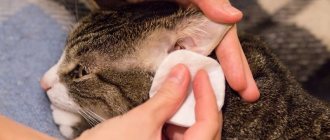12025Administration
While observing his pet, the owner may notice some oddities in his behavior. For example, he notices that the cat is shaking its head and at the same time scratching its ears with its paws. A suspicious person may suspect something wrong in any trifle, however, some vigilance never hurts, especially when it comes to cat ears. A cat has naturally very acute hearing, so its ears are very important to it. Problems with the hearing organs can bring her a lot of trouble.
If a cat shakes its head and scratches its ears, could this be an alarming symptom, or should it not be paid any attention to?
Pathological signs
Minor rare scratching (2-3 times a day) and head shaking cannot be called odd: all living organisms scratch and shake their heads, cats are no exception. But if the cat begins to itch constantly and at the same time tears his ears with his paws with all his might, you should pay special attention to this. These symptoms are often accompanied by other alarming signs that should alert the pet owner. These are the signs:
- The animal behaves restlessly, gets irritated and nervous for no reason.
- The cat actively shakes its head, tilts it down or to the side.
- When scratching its ears, the pet emits a hiss or an angry purr, and meows pitifully and loudly.
- Scratching left bloody marks inside and around the ears.
- The cat is trying to rub its muzzle and ears on everything around it.
- It is possible that the cat's body temperature may increase.
- The animal does not allow its ears and head to be touched, reacting painfully to any touch.
- The inner surface of the ear becomes red or swollen.
- Various discharges flow from the ear.
- Brown crusts and ulcers appeared in the ear.
Have you noticed this behavior in your cat? So it's time to see the vet.
© shutterstock
What treatment will be prescribed?
Depending on the nature and complexity of the disease, the veterinarian will prescribe appropriate therapy. These could be antibacterial ear drops, antiparasitics, antihistamines. In the initial stages of the disease, local exposure will be sufficient. If the problem is advanced, long-term systemic treatment and even surgery may be required.
All medications and procedures will be prescribed by a specialist. Your task is to monitor your pet, notice any deviations from usual behavior and promptly contact a veterinarian. The life and health of your cat is in your hands!
Reasons for strange behavior
If a cat's ears itch and it shakes its head, then the reason may be hidden in the most ordinary phenomena. This, for example, could be earwax that has accumulated in large quantities or water that has penetrated into the auricle during water hygiene procedures. Or perhaps a foreign object has gotten into your pet’s ear, or there are fleas.
There are other factors that may explain why a cat shakes its head. These symptoms are caused by specific cat diseases, as well as pathologies common to both humans and cats. Here are the main ones of these ailments:
- inflammation of the ear canal (otitis media);
- presence of tumors;
- hematoma or other head injury;
- fungal infection of the skin of the ears;
- dermatitis;
- allergic reaction;
- ear mites or other parasites that cause scabies.
All these conditions require specialist consultation and immediate treatment.
First, it’s worth taking a closer look at some of the most common diseases of furry pets.
Foreign body
A foreign body entering the ear canal causes the cat to shake its head and behave restlessly. If the splinter is not removed in time, the development of purulent otitis media is inevitable. The foreign body can be thorns from a cactus, plants, or the remains of claws after a fight with relatives. When removing the splinter yourself, it is recommended to thoroughly disinfect the wound and the tools that will be used to remove the splinter. If after extraction no purulent discharge or unpleasant odor appears within 3-5 days, then we can assume that everything went well. Otherwise, it is better to immediately take your pet to the veterinarian.
Ear mites
A cat constantly scratches its ear and shakes its head if it has parasites. Infection with ear mites occurs from other cats; contact with street animals is especially dangerous.
This mite is not dangerous to humans; it lives and reproduces only in animals, causing ear scabies or otodecosis in them. Adult dogs and cats rarely suffer from scabies, but ear mites are found much more often in puppies and kittens.
The parasite is localized in the ear area or around it. In the animal's ears, you can notice a sticky brown liquid that dries and crusts over the skin of the ear. To diagnose the disease, a scraping is made from the skin in the ear area. The owner himself can notice the tick using a magnifying glass.
© shutterstock
Prevention
- Keep your pet's ears clean and take care of them. Clean them once a week.
- Monitor your pet's walks. Limit contact with sick and homeless animals.
- Inspect your furry's body yourself for scratches and wounds and treat them as necessary.
- Keep your home clean. Parasites such as ear mites can live right in your home due to poor hygiene.
- Boost your cat's immunity. To do this, you need to control your pet’s diet. With a good immune system, the body itself will be able to fight certain diseases.
Keep an eye on your pet. Please note that you should not skimp on your pet’s health, because he is a full-fledged member of the family. We must be responsible for those we have tamed. It is very important to be able to understand your pet, and then you will intuitively feel his health problems. All the best!
Video from the clinic What to do if your cat scratches its ears
Sarcopid mites
If your cat's ears are shaking, this could be a sign that she has another type of mite. Such mites can spread not only in the ear area, but also in other parts of the cat’s body. They cause another feline disease, notoedrosis.
The head is affected first, then the entire body. The skin at the site of infection becomes dry and dense, covered with a crust, and the crust subsequently cracks.
To make an accurate diagnosis, you need to show the cat to a specialist. He will take a sample from the surface of the skin for analysis. Only the outermost layer from the inflamed area is scraped off; ticks can be seen there.
Both types of ticks provoke severe itching in the animal, forcing them to scratch the skin until it bleeds. Scabies that affects the ears can lead a cat to deafness or meningitis; in especially severe cases, the death of the pet can occur.
Allergy
It can often manifest itself as dirty ears, itching, redness and baldness in specific areas of the body. In severe forms, the cat shakes its head and scratches its ears. You can see black discharge inside the ear canal. If there is a strong odor, then there is a possibility of a fungal or bacterial infection. This reaction is almost always provoked by incorrectly selected food and feeding the pet from the table. You also need to rule out flea dermatitis and allergies to parasites. Decorative breed cats (British, Scottish, bobtails, sphinxes, etc.) are prone to allergies. You need to understand that it will not be possible to get rid of dermatitis once and for all, so the animal will need special care throughout its life (hypoallergenic food, timely worming and flea treatment).
Otitis and its varieties
Otitis is an inflammatory process affecting the external, middle or internal auditory canal. There may be several reasons for the development of such a pathology:
- excess wax in the ears;
- colds caused by prolonged exposure to the cold;
- foreign bodies entering the ear;
- infections;
- allergy;
- diseases of internal organs (liver, pancreas);
- fungus;
- complication of notoedorza or otodecosis.
To prescribe the correct treatment, it is necessary to diagnose the cause of the disease in a specialized laboratory. The veterinarian must take a swab from the cat's ear for analysis.
In addition to ordinary otitis, in cats there is otitis of a bacterial nature, when a secondary bacterial infection is added to the inflammation of the ear.
In this case, the so-called bacterial or secondary otitis develops. It can be recognized by the abundant discharge of pus.
© shutterstock
Otitis of mixed etiology also occurs in animals. This happens when the ear is affected by several types of otitis media at once. In this case, the disease occurs in a particularly severe form and causes serious complications.
Neoplasms
Often found in individuals after 5 years of age. They have benign (polyps, papillomas) and malignant
nature (sarcoma, lymphoma, carcinoma, melanoma). Almost always, all neoplasms provoke the development of otitis media and discharge from one (affected) ear. In advanced cases, the cat shakes its head and leans to the side. For single polyps of small size, you can limit yourself to observation and in the absence of growth and inflammation, you can leave it alone. If the polyp increases in size or provokes otitis media, then its removal is necessary. The prognosis is favorable in most cases. Everything is more complicated with malignant tumors, due to which blood and pus can be released from the ears. There is a foul odor. To confirm the diagnosis and determine the stage of the tumor, otoscopy, MRI of the head and radiography are performed. In the absence of metastases, surgical excision of the formation is performed, including healthy tissue (in 70% of cases, the entire ear canal is removed). And even if the operation is successful, the prognosis is cautious, since malignant tumors in the ears are prone to recurrence.
How to help your pet
Options for providing assistance to the injured animal are selected after establishing the exact cause of the pathological condition.
Removing wax plugs at home
The cat begins to shake its head if it is bothered by wax plugs. You can clean your pet's ears yourself. Saline solution or hydrogen peroxide will help in this situation. The selected product is instilled into the ear canal, 2-3 drops three times a day. The treatment course lasts 7 days . Subsequently, the animal usually successfully copes with this problem on its own.
If the cat is unable to remove the plug, the owner himself can remove it using a cotton-tipped swab or a piece of gauze. As a last resort, it is recommended to contact a veterinary clinic.
Surgical intervention
This type of treatment will have to be used if a tumor or foreign object is discovered in the cat that cannot be removed in any other way.
Surgery may also be recommended in cases of chronic otitis media, which results in narrowing of the ear canal.
Feline dermatitis
Has your cat started shaking his head all the time? Perhaps he has dermatitis. The disease is treated as follows:
- Remove the crust with a piece of cotton wool or gauze using hydrogen peroxide.
- Lubricate weeping ulcers with preparations with astringent properties (“Silver nitrate” 2%).
- Place drops containing novocaine into the ear canal. This will help relieve attacks of itching.
Continue treatment until symptoms disappear completely.
Fungal infections
If the fungus has entered the cat's ears, he begins to actively shake his head. In this situation you need to act like this:
- Every day, clean the ears with Chlorhexidine (0.05% solution).
- Give the animal the antifungal drug “Ketoconazole” for internal use, dose – 5 mg per 1 kg of cat’s weight. Take twice daily.
- Otibiovin drops will have an effective effect. They need to be instilled several times a day into the pet’s ear.
© shutterstock
Fleas
If there are fleas, you need to start treatment immediately. The following steps will help get rid of parasites:
- The ear needs to be treated with a special preparation against parasites.
- After some time, clean the auricle from dead insects with a piece of cotton wool soaked in hydrogen peroxide.
- The entire cat should be thoroughly washed with flea detergent.
If necessary, the procedure must be repeated.
Ear scabies mites
This attack is treated with special antiparasitic and anti-inflammatory drugs:
- in the form of ear drops, ointment preparations (“Tactic” or “Amit”);
- in the form of injections (“Otodecnin”);
- Hydrogen peroxide and a soft tampon are used to remove purulent plaque in the ear.
Both ears must be treated at once, even if symptoms are found in only one.
How is notoedrosis treated?
Parasites must be combated with ointments and special detergents: tar, sulfur sediment, green soap.
In case of a particularly severe form of infection, use “Hyposulfite” and “Benzyl benzoate” to treat the affected areas.
If purulent formations appear, antibiotic treatment must be added.
© shutterstock
Otitis
Inflammation of the ear canal can be cured using a whole range of measures:
- if there is purulent discharge, it is removed with hydrogen peroxide and a piece of cotton wool;
- drops are instilled against otitis (Aurikan, Surolan, Oridermil, Oritsin, Bars);
- Novocaine is used to relieve pain (it is injected at the base of the animal’s ear);
- For allergic otitis, antihistamines are used.
For otitis media of a bacterial nature, the cat is treated with Otonazole, Mastiet, and Otibiovin. These are preparations for topical use.
Allergy in a cat
Animals, like people, also have allergies. Often such a reaction occurs to certain types of food or household chemicals. An allergy can be suspected if the cat shakes its ears, and at the same time its ears are clean . Treating such an ailment is simple: they use the same means that treat allergies in people (antihistamines for oral and local use).
Injuries
Domestic cats experience fewer injuries, since there are many risks on the street in the form of fights with relatives or other animals. If the injury is severe (for example, after a fall from a height), the pet may shake its head for a while and lean to one side. If this condition does not go away within 24 hours, it is recommended to immediately take him to the nearest veterinary clinic. To make a diagnosis, it will be necessary to exclude injuries to the skull, cervical spine, and concussion. Injuries can also include insect bites, after which the cat not only shakes its head, but also rushes around the house. We are talking about wasp and bee stings in the area of the nose, lips, ears and eyes. The bite site always swells and turns red. It is recommended to immediately give your pet an antihistamine (Fenistil, Cetirizine).
What to do
Any number of scratches on the skin can cause abrasions, irritation and cracks. It is wise to give your cat an antibiotic (prescribed by a veterinarian) and apply topical antibacterial ointments and creams to avoid further infection and discomfort.
Cats carry a lot of bacteria and germs under their claws, and this is made worse by using a litter box. This makes them very susceptible to infection, especially when the claws introduce viruses, parasites and bacteria into open wounds through the claws. When your cat starts scratching her ears and shaking her head, it's time to take a look!
© shutterstock
Why does my cat shake her head, scratch her ears, and have brown discharge?
If your cat occasionally shakes its head and scratches its ears, there is most likely no cause for concern. However, when the itching becomes constant, this should alert the owner. Gradually, scratches appear on the ears from the claws. If something bothers the cat, it may press its ears, which is also a sign of the development of pathology. The pet’s mood also changes: it becomes nervous due to discomfort.
The reasons for this condition may be different. Itching is caused by fungal, bacterial infections, fleas and many other factors. When such symptoms appear, you need to pay attention to discharge from the ear canals. The accumulation of a brown mass, the formation of dark scabs, and an unpleasant odor are often symptoms of one of the dangerous diseases, such as otitis media or ear scabies.
With otitis media, the inflammatory process caused by fungi or bacteria covers the structures of the inner and middle ear. This group of pathologies often leads to deafness in the absence of timely treatment.
Sticky brown discharge with a specific odor is a typical sign of otodectosis. When affected by ear mites, cats also shake their heads, as when they have inflammation of the inner ear. Only a veterinarian can make an accurate diagnosis based on the results of the examination.
Otodectosis (ear scabies)
Otodectosis is one of the most common pathologies found in cats. It is caused by microscopic mites that live in the ear canal. These parasites damage the epithelial layer in the ear and injure the eardrum, feeding on blood, epithelium, lymph and wax. The main symptoms of ear scabies:
- severe itching in the ears;
- brown discharge;
- scabs and crusts in the ear canal.
Otodectosis
When infected with ear mites, a cat presses its ears, scratches them, tearing the skin into blood. If you do not help your pet, he may develop one of such dangerous diseases as meningitis and otitis media.
Otodectosis should be treated by a veterinarian. Therapy depends on the severity of the pathology. As a rule, acaricidal drugs (killing ticks) are used. In advanced cases - when a bacterial infection is attached - the animal is prescribed tetracycline antibiotics.
Otitis of various etiologies
Otitis media, or ear inflammation, is also common in cats. Diagnosis and treatment of otitis media is always carried out by a veterinarian. The main symptoms of this disease are:
- dirty ears;
- purulent discharge, ichor;
- itching;
- decreased appetite;
- unsteady gait (with damage to the vestibular structures).
Otitis media can be caused by various reasons. Some breeds of cats are more likely to develop otitis due to the structure of their ears, for example Scottish Folds, whose ears are pressed to the head and the auditory canals are narrowed. Among the external factors that cause otitis media are the following:
- fungal or bacterial infections;
- ear injuries resulting from foreign bodies or improper handling;
- parasitic lesions.
Ear cleaning
In order to prevent ear diseases and as a hygiene measure, it is necessary to clean cats' ears regularly. You can do this yourself at home, and those who are afraid or do not know how to carry out this procedure can seek help from a veterinary clinic.
The most important thing is to create a calm environment and not scare the cat. It is not necessary to hold it by force, tug and wrap it, it is enough to gently win the pet’s obedience.
Use a small piece of cotton wool to wipe the auricle from accumulated wax. Then you can drop a couple of drops of saline solution and massage your ear so that the liquid penetrates as deep as possible into the ear canal. Next, use a cotton swab to clean hard-to-reach places. Ear hygiene should be carried out at least once a month.











